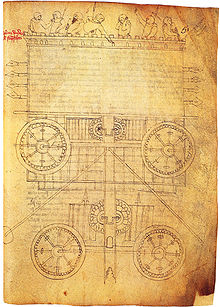Guido da Vigevano

Guido da Vigevano or Guido da Pavia (born c. 1280; died c. 1349) was an Italian physician and inventor. He is notable for his sketchbook Texaurus regis Francie which depicts a number of technological items and ingenious devices, allowing modern scholarship an invaluable insight into the state of medieval technology. Although still attached in style and spirit to the Middle Ages, Guido da Vigevano can be regarded as a distant forerunner of later Renaissance artist-engineers like Taccola, Francesco di Giorgio Martini and Leonardo da Vinci.
Guido da Vigevano was personal physician of queen Joan the Lame (Jeanne de Bourgogne).[1] For an envisaged crusade,[2] he drew sketches of armored chariots, wind-propelled carriages and siege engines. He was also one of the first to add drawings of organs to his anatomical descriptions in a second treatise, The Anothomia. His sketches were typically medieval in that they lack perspectivity, invented only at the beginning of the Renaissance by Brunelleschi.
Guido created a vehicle that moved using a windmill that relayed force to gear and then to the wheels. Some consider this machine to be first car in history, or at least a forerunner.[3][4]
See also
References
- ^ "Vom Winde gedreht" [Turned the Wind]. Die Zeit (in German). February 2001. Retrieved 17 September 2015.
- ^ "Guido Vigevano's Wind Car (1335)". No Tech Magazine. 16 July 2009. Retrieved 17 September 2015.
- ^ Bottorff, William W. "What Was The First Car? A Quick History of the Automobile for Young People". Austin Business Computers. Retrieved 17 September 2015.
- ^ "The First Car and then Some More". Automobile in Design. 27 May 2010. Archived from the original on 27 May 2010. Retrieved 17 September 2015.
Further reading
- Hall, Alfred Rupert: "The military inventions of Guido da Vigevano", Actes du Congrès International d'Histoire des Sciences, 8, Vol. 3 (1956), pp. 966–969
- Hall, Alfred Rupert: "Guido's Texaurus, 1335", in: Hall, Bert Stewart / West, Delno C. (Eds.): On Pre-Modern Technology and Science (Undena Publications), Malibu 1976, pp. 11–51
- Hall, Bert Stewart, Giovanni de Dondi and Guido da Vigevano: "Notes Toward a Typology of Medieval Technological Writings", Annals of the New York Academy of Sciences (1978), pp. 127–142
- Hall, Bert Stewart: "Guido da Vigevano's Texaurus Regis Francie, 1335", in: Eamon, William (Ed.), Studies on Medieval Fachliteratur, Brussels 1982, pp. 33–44
